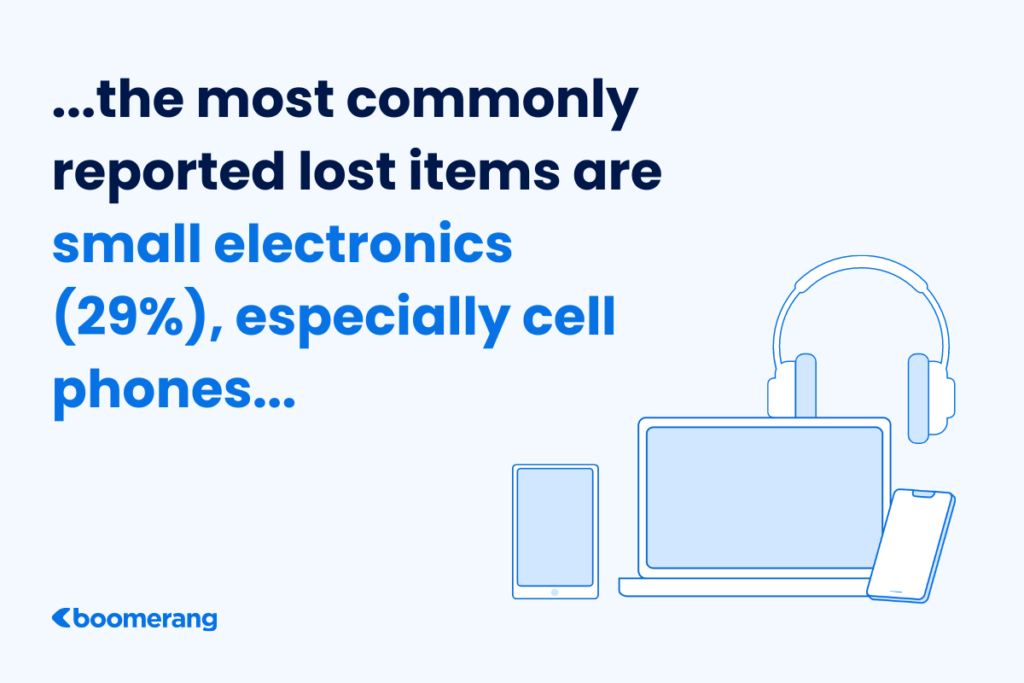
Boomerang, the leading lost and found platform, partnered with a global management consulting firm to investigate Lost and Found. We launched a detailed survey to understand what items are most commonly lost, where they are lost, and if and how they get recovered.
We recently surveyed over 1,000 participants across demographics and psychometrics, including age, income, education level, geography, and travel frequency. The findings were, in some cases, expected but in other cases, surprising.
Below are the findings that stood out.

Who loses items?
A vast majority of respondents reported losing at least one item a year. There wasn’t one demographic that qualified as “the biggest loser,” nor were there stark differences based on age, gender, ethnicity, or socioeconomic status.

Which items get lost most?
The most commonly reported lost items are small electronics (29%), especially cell phones, followed by keys (11%), glasses (11%), cash (9%), jewelry (8%), clothing (8%), and water bottles. We suspect less valuable items are lost with greater frequency but too often are not remembered or don’t get reported.

Where are items lost most?
The vast majority (86%) of lost items are reported lost while passing through a business location.
- One in four items are lost while traveling – hotels (8%), rideshare and taxis (8%), airports/airlines (6%), and public transit (4%). This makes sense – people in a hurry must keep track of many things simultaneously, and something is prone to fall through the cracks.
- The remaining 75% of lost items go missing across restaurants, parks, movie theaters, amusement parks, bars, stadiums, and more. So, people can let their guard down almost anywhere.

How often are items lost?
All respondents own up to losing at least one item annually; 25% said they only lose one item a year, and similar percentages report losing two and three items annually. Only 10% report losing four items, while 21% of respondents reported losing at least five items each year.
Do people replace their lost item?
Not surprisingly, people replace necessary items like phones, headphones, and charging cables, but in other cases, they choose to do without the lost item. Half of those reporting lost items bought replacements at online stores (Amazon and Walmart, in particular), 39% bought at a retail store, while 12% did not replace their lost item.
Do people try to recover the lost item and how?
Just over half (57%) report making an attempt. Common approaches were calling the business or going to the business in person. Respondents that follow up spend between 30 minutes and 2 hours. Most of those attempting to retrieve their item from a business made at most two attempts before giving up.
85% of participants are not aware of an online platform to help recover a lost item at a business.
Less than 15% post online when they lose an item in public. The common platforms used are Facebook (#1 used platform), followed by Twitter and NextDoor. The survey results indicate that legacy platforms like Craigslist have become increasingly less relevant.
How did successful participants retrieve their lost items?
Most often, they did so by picking them up (87%). Those requesting shipping usually (60%) pay for that service.
What is the buying behavior of people unable to retrieve their items?
They buy a new one 81% of the time, indicating the importance of the items, such as cell phones. Usually, they buy quickly, but almost 25% wait a week, likely owing to the hopes of retrieving their original item.
Do people submit insurance claims for lost items?
Not often. Only 20% of people report filing insurance claims. In some cases, insurance restricts coverage, making it impossible, even if it is desired. The more valuable the item, though, the more likely someone is to file a claim.

Our research has given us insights about lost and found behaviors. It is one piece of a complex puzzle that entails ongoing research. An exciting technological advancement has been the introduction and fast adoption of device tracking devices. Next, we look at how this technology is impacting the process of item recovery.
Even Apple is doing their part to solve Lost and Found with their AirTag, which is growing like wildfire. And it’s not just Apple who’s growing fast — Tile and other device trackers are also growing quickly. Apple has now sold over $1 billion worth — or about 55 million units — since April 2021. Tile, Apple’s largest rival in the space, isn’t far behind, having sold over $800 million worth, or 40 million units, of its technology.
Google is reportedly going to jump into the fray, with rumors swirling that the company could announce a product this year. With over 3 billion active Android phones globally, any entrance from Google into the space should accelerate the growing adoption of the technology.
The future growth of device tracking is a phenomenal advancement in transparency – but it often takes two parties to reunite a lost item.
The reality of the situation is it takes two dedicated parties to successfully retrieve a lost item that is found by a person or business.
If businesses do not match their own investment into this lost and found problem by partnering with a smart lost and found management software like Boomerang, customer tracking of the lost item will continue to be frustrating and inefficient, resulting in a bigger problem for the business than the lost item itself.

Skyler Logsdon
CEO, Boomerang